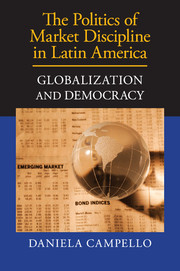Book contents
- Frontmatter
- Dedication
- Contents
- List of Illustrations
- List of Tables
- Acknowledgments
- 1 Globalization, Democracy, and Market Discipline
- 2 Between Votes and Capital: Redistribution and Uncertainty in Unequal Democracies
- 3 Investors' “Vote” in Presidential Elections
- 4 The Politics of Currency Booms and Crises: Explaining the Influence of Investors' “Vote”
- 5 Currency Crisis, Policy Switch, and Ideological Convergence in Brazil
- 6 Exogenous Shocks and Investors' Political Clout in Ecuador
- 7 One President, Different Scenarios: Crisis, Boom, and Market Discipline in Venezuela
- 8 “Vivir con Lo Nuestro”: Default and Market Discipline in Argentina
- 9 Who Governs? Market Discipline in the Developed World
- 10 Conclusion: Markets' Vote and Democratic Politics
- References
- Index
10 - Conclusion: Markets' Vote and Democratic Politics
Published online by Cambridge University Press: 05 April 2015
- Frontmatter
- Dedication
- Contents
- List of Illustrations
- List of Tables
- Acknowledgments
- 1 Globalization, Democracy, and Market Discipline
- 2 Between Votes and Capital: Redistribution and Uncertainty in Unequal Democracies
- 3 Investors' “Vote” in Presidential Elections
- 4 The Politics of Currency Booms and Crises: Explaining the Influence of Investors' “Vote”
- 5 Currency Crisis, Policy Switch, and Ideological Convergence in Brazil
- 6 Exogenous Shocks and Investors' Political Clout in Ecuador
- 7 One President, Different Scenarios: Crisis, Boom, and Market Discipline in Venezuela
- 8 “Vivir con Lo Nuestro”: Default and Market Discipline in Argentina
- 9 Who Governs? Market Discipline in the Developed World
- 10 Conclusion: Markets' Vote and Democratic Politics
- References
- Index
Summary
In the years of exuberance that preceded the global financial crisis of 2008, the very notion of an existing trade-off between votes and capital seemed outdated in Latin American emerging economies. On the contrary, the decade was marked by exceptional optimism, both in financial markets and among voters.
Evidence of this win–win scenario, dramatic decreases in sovereign bond yields occurred in parallel to very high levels of presidential popularity and a wave of reelections in the region, irrespective of the quality or ideology of the administration.
Moreover, different from the 1980s and 1990s when most leftist governments in Latin America abandoned their original program in favor of a neoliberal agenda, the 2000s witnessed a widespread “move to the Left,” which became subject to much debate among political economists focused on the region.
Following the “great recession,” an opposite trend observed in Europe – an alleged “move to the right” – has also attracted increasing attention of the specialized media and academics (Lindvall 2011; Magalhães 2012).
Left-wing parties lost vote share in the majority of elections held since 2009 (Bartels 2011); most importantly, however, left-leaning governments have to a large degree abandoned their agenda in favor of orthodox economic policies, as seen in the previous chapter. Bartels finds that, all else equal they may have spent slightly less on stimulus programs than their right-wing counterparts.
The theory presented in this book suggests that these trends are different manifestations of the same mechanism; they reflect substantial changes in creditors' capacity to influence policymaking, which in both cases were prompted by exogenous economic conditions.
Whereas an unprecedented boom in commodity prices, coupled with high international liquidity, provided leftist governments in the emerging world with increased room to maneuver in the 2000s, capital scarcity following the American subprime mortgage crisis contributes to explain the peak of market discipline in Europe after 2008. With the crisis, resources to fund current account deficits we re suddenly no longer available to countries that had become used to growing with foreign savings, the same way Latin American emerging markets did in the early 1990s.
- Type
- Chapter
- Information
- The Politics of Market Discipline in Latin AmericaGlobalization and Democracy, pp. 214 - 220Publisher: Cambridge University PressPrint publication year: 2015

